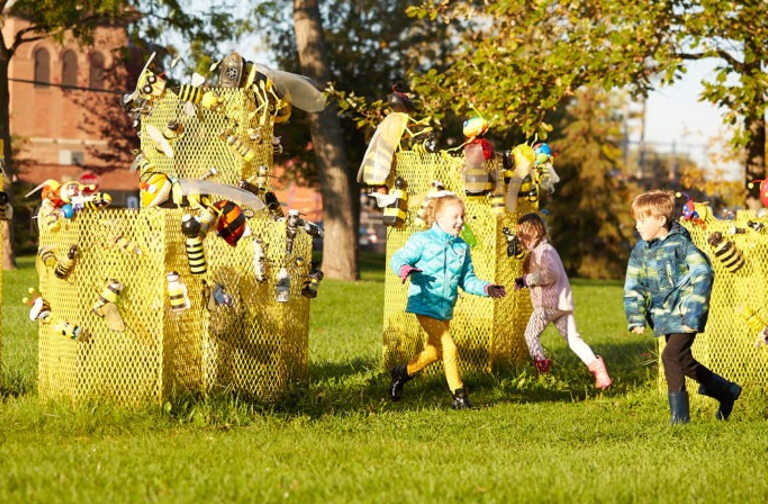If you drive through the historical Bohemian Village in Cedar Rapids, you can see large bright yellow hexagonal structures covered with hundreds of bees made from recycled materials.
One might see children playing around the installation, like the boy in this photograph, admiring the bee made from a Rubik’s cube – he thinks it’s such an inventive idea! He, his younger sister, and their cousin made their bees from plastic bottles and tape and added them to the installation a few weeks earlier. Now they are often checking on their own and other people’s creations: there is an enormous bee made from two biking helmets, there is a tiny one from the nail polish bottle, there is a bee crocheted from yellow and black yarn, there is one made from old plastic toy and used kitchen mixing bowl! Furthermore, it’s a great place to hang out with friends!
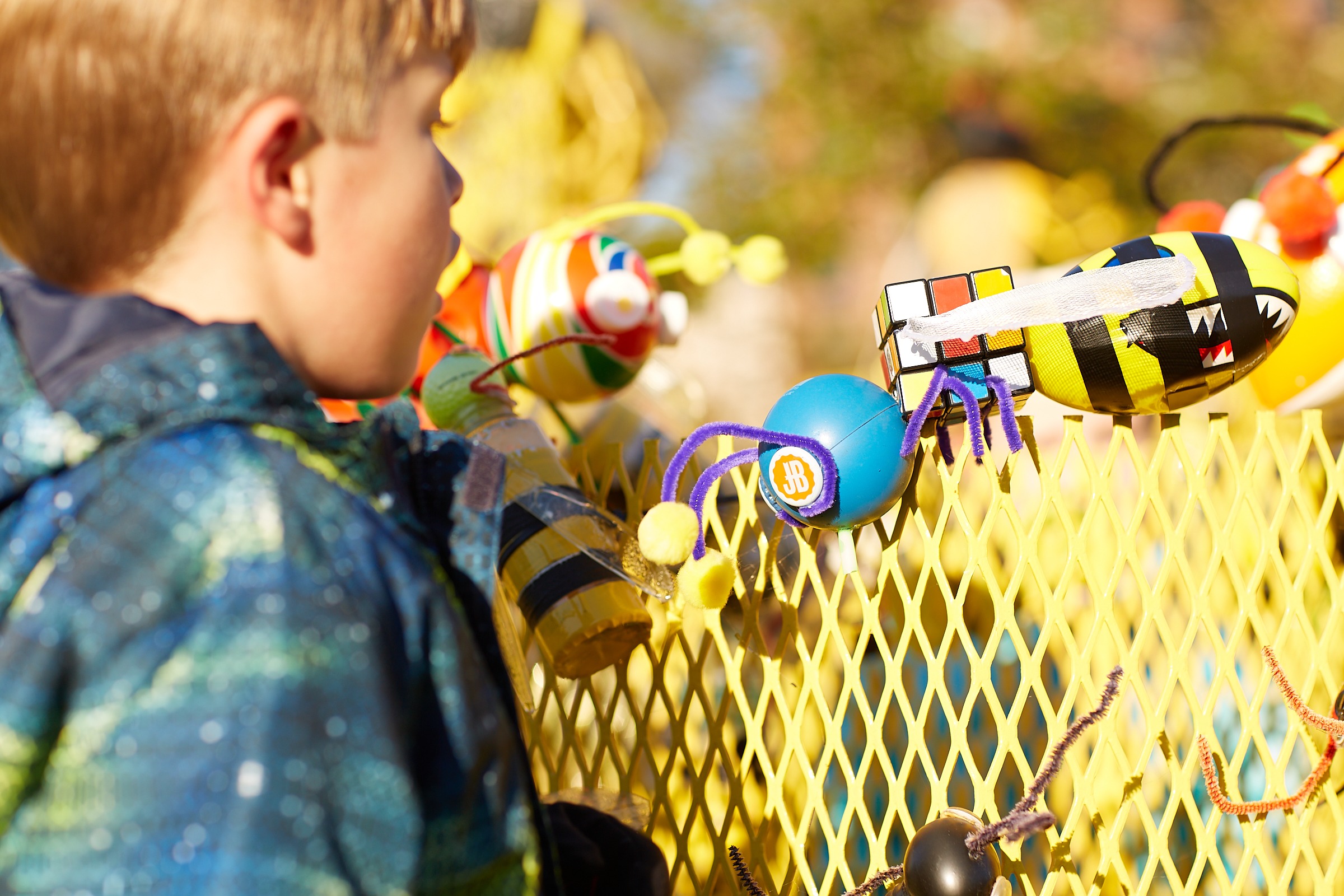
Photograph by Brendan Pole
And there is more to come. Starting this April, two more public works by Russian American multimedia artist Elena Smyrniotis will be installed in Iowa. Growing up, Elena spent summers in her grandmother’s village, well known for beekeeping, where she roamed the open fields bursting with wildflowers and bees. These early memories reoccurred in The Bee Project, developed during her Grant Wood Artist Fellowship at the University of Iowa. The Bee Project is a community engaging art installation designed by the artist in collaboration with the University of Iowa Office of Sustainability and the Environment, the Office of Community Engagement, Grant Wood Art Colony, Indian Creek Nature Center, and Czech Village/New Bohemian District in Cedar Rapids, Iowa. By involving a wide range of participants, The Bee Project urges viewers to protect fragile ecosystems and to help ensure the future of pollinators. Using reclaimed objects and recycled plastics, Elena highlights the problem of overproduction and overconsumption and encourages her audience to make a global impact through everyday actions. Currently displayed in Cedar Rapids and Indian Creek Nature Center in Iowa, the project will expand to downtown of Iowa City, Iowa Lakeside Laboratory in northwest Iowa, and to other states in 2022.
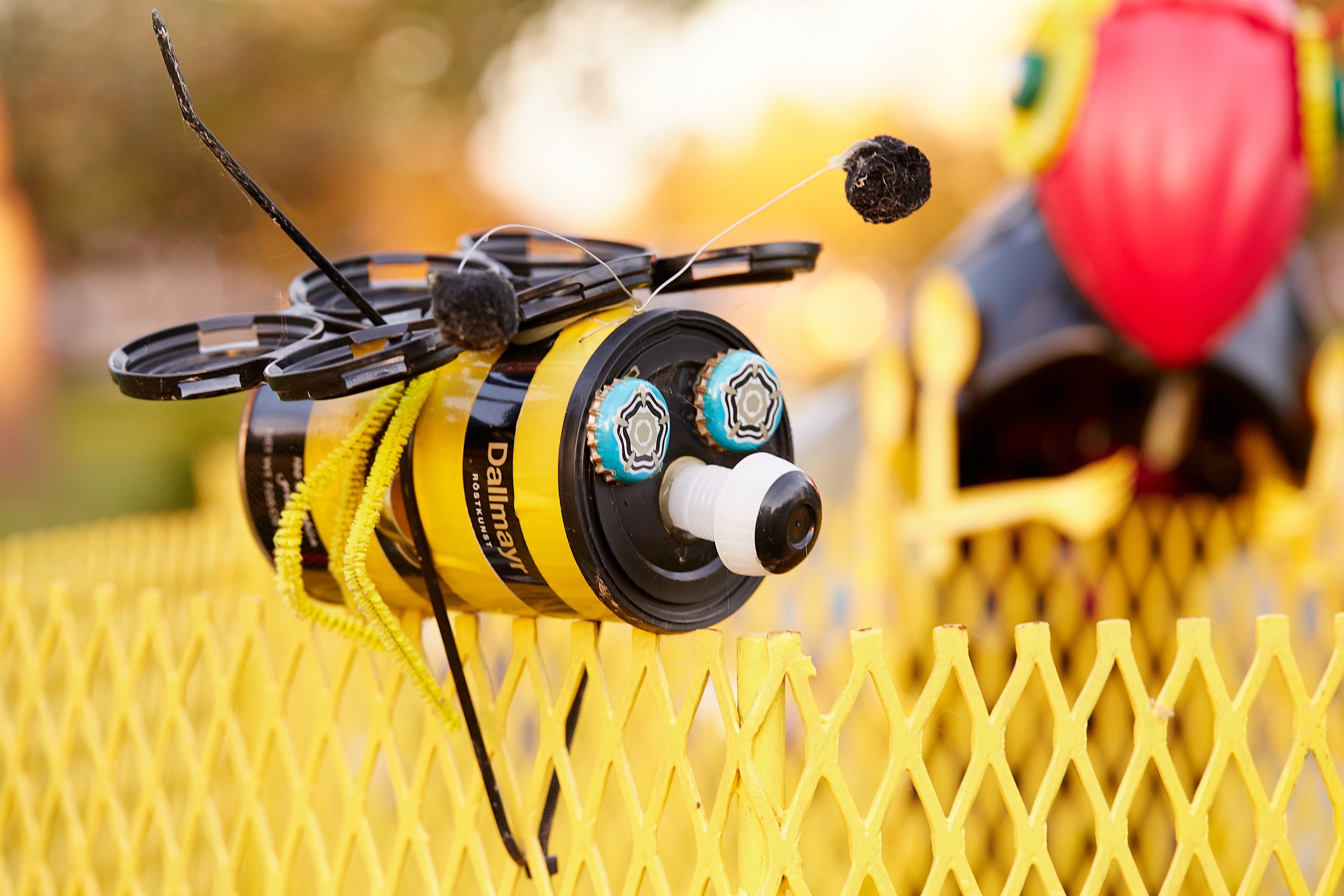 Photograph by Brendan Pole
Photograph by Brendan Pole
In the last debate of the Royal Geographical Society of London, the Earthwatch Institute concluded that bees are the most important living beings on the planet. However, scientists have also concluded that bees have already entered extinction risk.
The Bee Project involves art, education, and science to draw attention to human-caused threats to the honeybee colonies and wild bees worldwide. Our mission is to engage local communities and motivate them to protect the bees. We provide art workshops, online instructions, and a series of lectures by the leading scientist in pollination ecology Stephen Hendrix, who dedicated the last 20 years of his research to studying community ecology and conservation of wild bees.
Pollinators are quite noticeable creatures that appear around us almost anywhere and anytime when we are outside, and flowering plants are nearby. They get our attention whether they are butterflies swooping along between plants or bees zooming around between flowers. By far, bees are the most numerous of the pollinators, but one must quickly distinguish between honeybees and other bees. Honeybees are familiar to most of us but are only one species of bee and the only one that lives in colonies with thousands of workers, generally in man-made boxes. In addition to honeybees, there are also thousands of wild or solitary bees species. These bees do not live in colonies, and the females usually nest by themselves in the ground or stems of plants. Altogether there are about 20,000 species globally of wild bees, and most Midwest states probably have 400-500 species. They come in an astounding variety of shapes, sizes, colors, and habits. Together, honeybees and wild bees provide an essential ecosystem service by completing plant reproduction of hundreds of fruits and vegetables that make our diets nutritionally balanced and exciting.
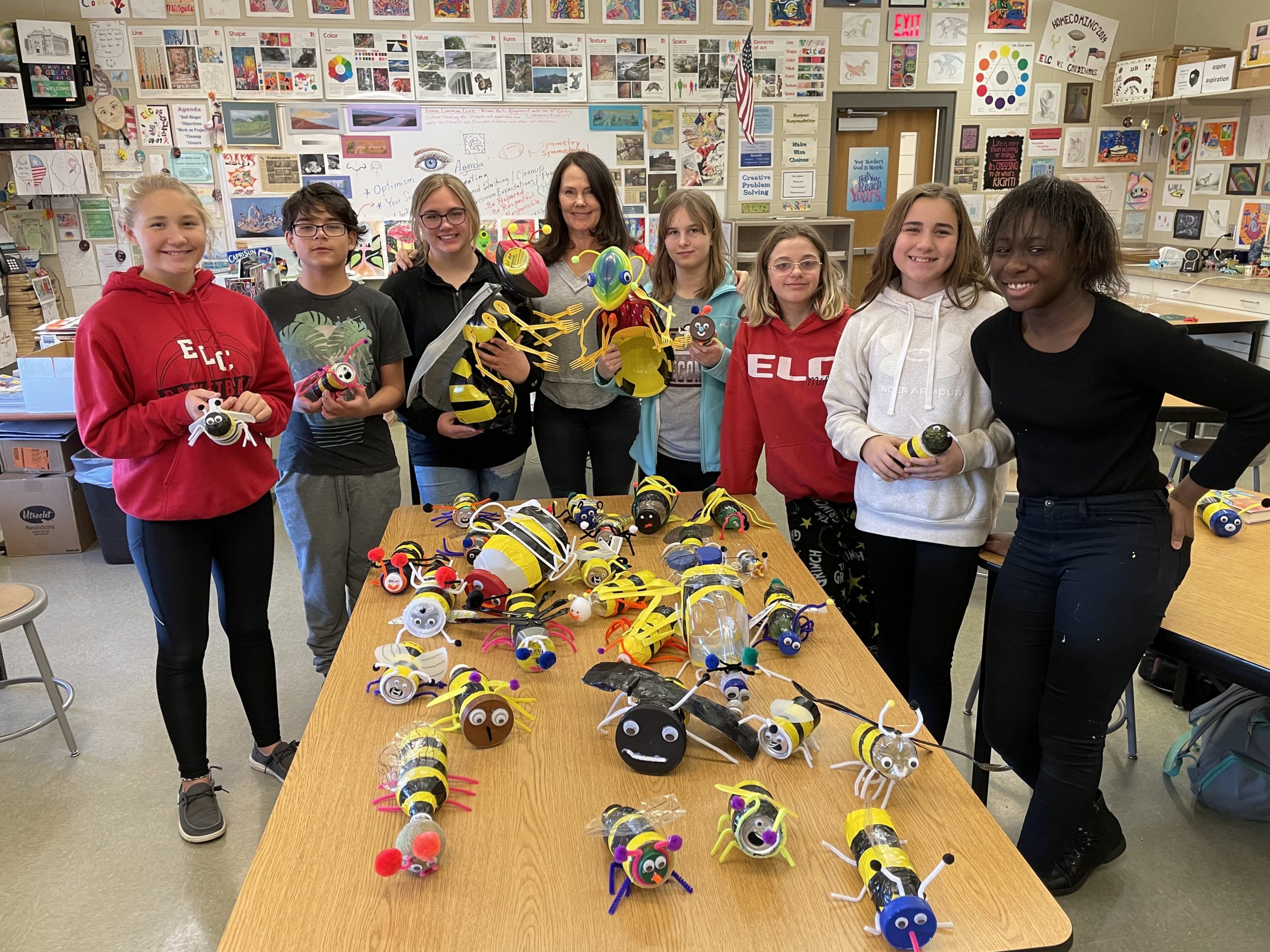
Estherville, Iowa Middle School BEE PROJECT WORKSHOP
Photograph by Brendan Pole
Honeybees are typically pollinators of monoculture crops such as almonds, coffee, and sunflowers. However, the research of Steve Hendrix and his colleagues in the almond groves of Central California showed that wild bees contributed a 15% improvement to the eventual almond crop if sufficient natural habitat was surrounding an almond grove. Furthermore, wild bees were more effective pollinators than honeybees because of the time spent in a flower, and the presence of wild bees make honeybees more efficient pollinators of almonds. Similar results have been found for many monoculture crops that depend on honeybees. In Iowa, Hendrix has shown that these wild, solitary bees are the most important pollinators in our gardens, produce farms, and native prairies. For prairie plants dependent on pollinators, Steve has also shown that greater wild bee diversity visiting a plant resulted in greater plant reproduction.
Threats to both honeybees and wild bees are numerous. For honeybees, pests and pathogens such as mites and viruses, environmental stressors like pesticides or poor nutrition, and genetic limitations all contribute in varying degrees to what has been popularized as “Colony Collapse Disorder”. For wild bees, the obvious threats come from the loss of habitat, reduction of floral resources, and loss of nesting sites. In addition, the use of chemicals in agricultural fields and the potential threat of climate change are of concern and continue to be studied.
Steve’s research is not only investigating the ecology of bee communities but also looking for ways to improve and protect them. His and others’ research has shown that small prairie patches or restorations will draw in and help sustain wild bees. They have identified from their studies six prairie species in Iowa that support a vast number of bees. Other ways to help wild bees are to create or leave bare areas without lawn for ground-nesting bees and have bamboo sticks or standing dead stems available for cavity nesters. Of course, the more flowering plants, the better and less lawn mowing, and chemical use help.
Steve is hoping that everyone will enjoy the installation of The Bee Project or even go and make some bees for display. And when all the plants are in flower, he encourages everyone to stop a moment and watch those amazing bees.
The Bee Project is an outdoor, site-specific installation that uses modular structures to resemble a beehive with sculptures of bees attached to it. The local community members are instructed to create bee sculptures from the recycled materials, mostly plastics and metals. The structures are welded from carbon steel mesh in the shape of hexagons and painted yellow to resemble a honeycomb. Yellow hexagons have similar sizes but vary in height from 3 to 6 feet; they are placed in various compositions in different locations with consideration of the existing landscape, buildings, trees, roads, and paths of human traffic. The Bee Project adds a vibrant and meaningful element into the fibers of the city, park, or nature center.
The Bee Project truly gives people a way to express themselves while bringing attention to the importance of pollinators. Smyrniotis designed this project for all ages, from elementary and middle school to college students and seniors. She travels to different places to bring The Bee Project to remote locations. For instance, in November of 2021, she gave a series of workshops to middle school students in Estherville, Iowa. This workshop resulted in approximately 150 bee sculptures made by 5th through 8th graders from material collected by the students.. The “Estherville bees” will “travel” to the installation in downtown Iowa City in April of 2022, making the students feel very proud and connected. The project also helps students rethink recyclable waste uses and transform discarded materials into beautiful art projects.
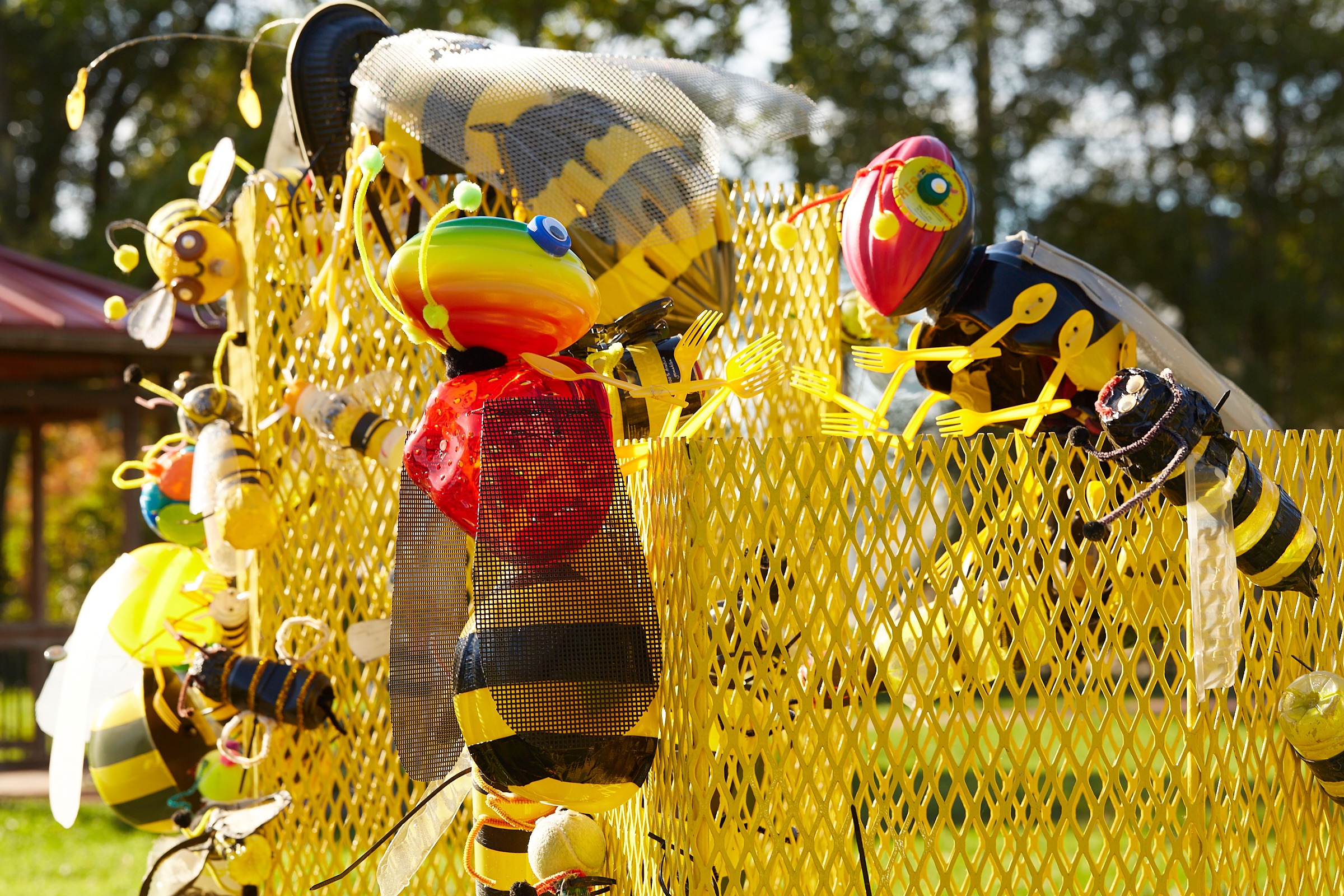
The Bee Project installation in Cedar Rapids, detail Photograph by Brendan Pole
The project was designed during the pandemic and considered COVID safety measures. It found ways for the community to be creative, connected, safe and, most importantly, included. The project provides online instructions and videos on building and installing bee sculptures, all while avoiding large gatherings. First, we build and install hexagonal structures outside. Second, the participants can make bees at home or in the classroom. The instructions suggest designs, materials, and tools that can be used to build bees; they also encourage participants to be creative and to come up with their own ideas and designs. Third, the bees can be attached to the structures at any time of the day with zip ties left onsite. So, this art project brings the community together without gathering large crowds and exposing people to COVID.
We understand that this art project alone will not save bees, however, it is a way of giving people the empowerment, voice and inspiration to improve their local environment. The Bee Project provides meaningful involvement of individuals and groups in the community and facilitates awareness and connections needed to make places thriving and sustainable. Smyrniotis believes that the great art can come from adversity, but also that adversity can be overcome through the art. She is convinced that we must address many environmental problems by standing together as a community.
Plans are underway to share The Bee Project nationwide with museums, nature centers, botanical gardens, zoos, and other organizations, which embrace art and environmental education.
 Elena Smyrniotis is a multimedia installation artist with a background in architecture. Currently, Elena is a Grant Wood Fellow in printmaking and Assistant Professor at the University of Iowa. Her large installations investigate the relationship between architecture, space, and abstracted topography to underline environmental anxieties in a constructed landscape. Elena’s most recent projects seek to address the climatic impact of melting ice caps and the progressive extinction of bees and other pollinators. She earned her MFA in printmaking from the University of Notre Dame, her MA in printmaking and drawing from the University of Saint Francis, and her MA in Architecture and Engineering from State Petroleum University, Ufa, Russia. Elena’s experience at a global network of cultural institutions includes a Fellowship at the Rome Global Gateway and cooperation with the Geographical Society of Italy; teaching art workshops in Dubai, OAE; partaking in workshops at The Painting School of Montmiral, France. Elena’s exhibition record includes shows in the USA, Russia, Spain, and Turkey.
Elena Smyrniotis is a multimedia installation artist with a background in architecture. Currently, Elena is a Grant Wood Fellow in printmaking and Assistant Professor at the University of Iowa. Her large installations investigate the relationship between architecture, space, and abstracted topography to underline environmental anxieties in a constructed landscape. Elena’s most recent projects seek to address the climatic impact of melting ice caps and the progressive extinction of bees and other pollinators. She earned her MFA in printmaking from the University of Notre Dame, her MA in printmaking and drawing from the University of Saint Francis, and her MA in Architecture and Engineering from State Petroleum University, Ufa, Russia. Elena’s experience at a global network of cultural institutions includes a Fellowship at the Rome Global Gateway and cooperation with the Geographical Society of Italy; teaching art workshops in Dubai, OAE; partaking in workshops at The Painting School of Montmiral, France. Elena’s exhibition record includes shows in the USA, Russia, Spain, and Turkey.
For further information, contact:
Elena Smyrniotis
Grant Wood Fellow
Visiting Assistant Professor, University of Iowa
Email: [email protected]
Website.
 Steve Hendrix is professor emeritus at the University of Iowa. He earned a Ph.D. at the University of California – Berkley and focused his research on plant-animal interactions, including reactions of plants to herbivores and pollination ecology of prairie plants. His last 20 years have been dedicated to the community ecology and conservation of wild bees with an emphasis on bee diversity in different habitats, including produce farms; small and large prairie fragments, and degraded, disturbed areas. His studies of bee communities in almond orchards in California also showed that wild bees are an essential component of pollination success for almond growers. His studies at small produce farms in Iowa show that most of the pollination there is done by wild bees even when honey bees are nearby. In addition to a long teaching career, he helped create and directed the Environmental Science Program at the University of Iowa and was Director of Academics and Research at Iowa Lakeside Laboratory, where he developed their successful Artists in Residence Program.
Steve Hendrix is professor emeritus at the University of Iowa. He earned a Ph.D. at the University of California – Berkley and focused his research on plant-animal interactions, including reactions of plants to herbivores and pollination ecology of prairie plants. His last 20 years have been dedicated to the community ecology and conservation of wild bees with an emphasis on bee diversity in different habitats, including produce farms; small and large prairie fragments, and degraded, disturbed areas. His studies of bee communities in almond orchards in California also showed that wild bees are an essential component of pollination success for almond growers. His studies at small produce farms in Iowa show that most of the pollination there is done by wild bees even when honey bees are nearby. In addition to a long teaching career, he helped create and directed the Environmental Science Program at the University of Iowa and was Director of Academics and Research at Iowa Lakeside Laboratory, where he developed their successful Artists in Residence Program.
Serving as Consulting Curator for The Bee Project is David J. Wagner, Ph.D., President, David J. Wagner, L.L.C. (davidjwagnerllc.com).
Teaser photo credit: “The Bee Project” installation in Historical Bohemian District in Cedar Rapids Iowa April-November 2021 Photograph by Brendan Pole


